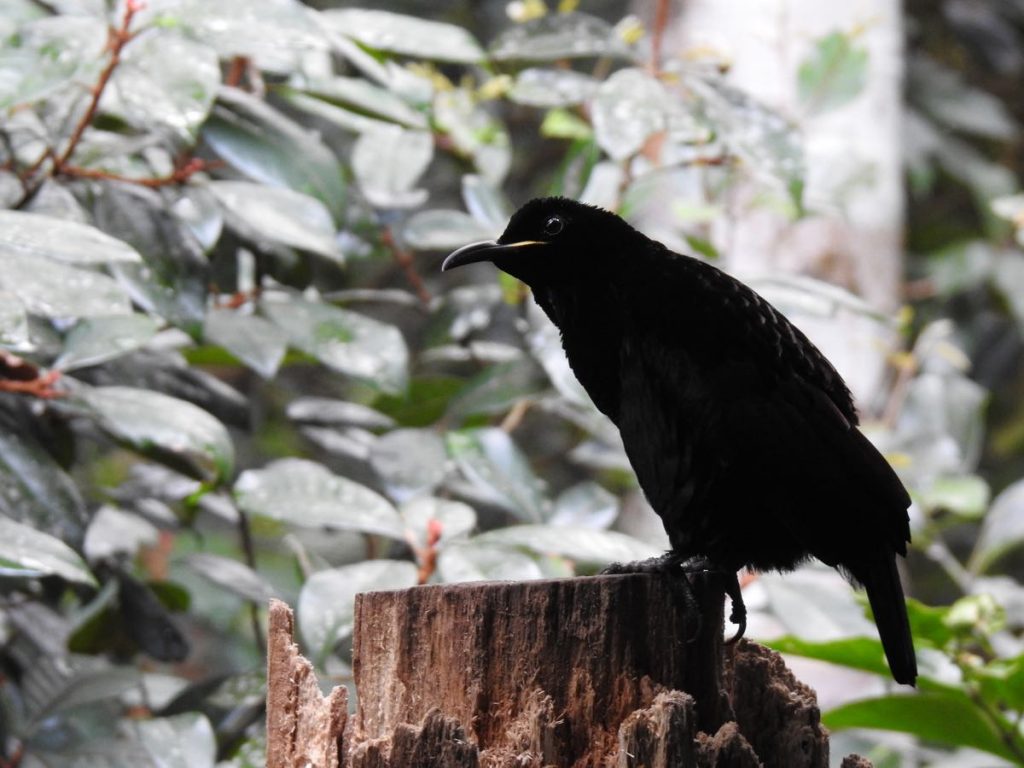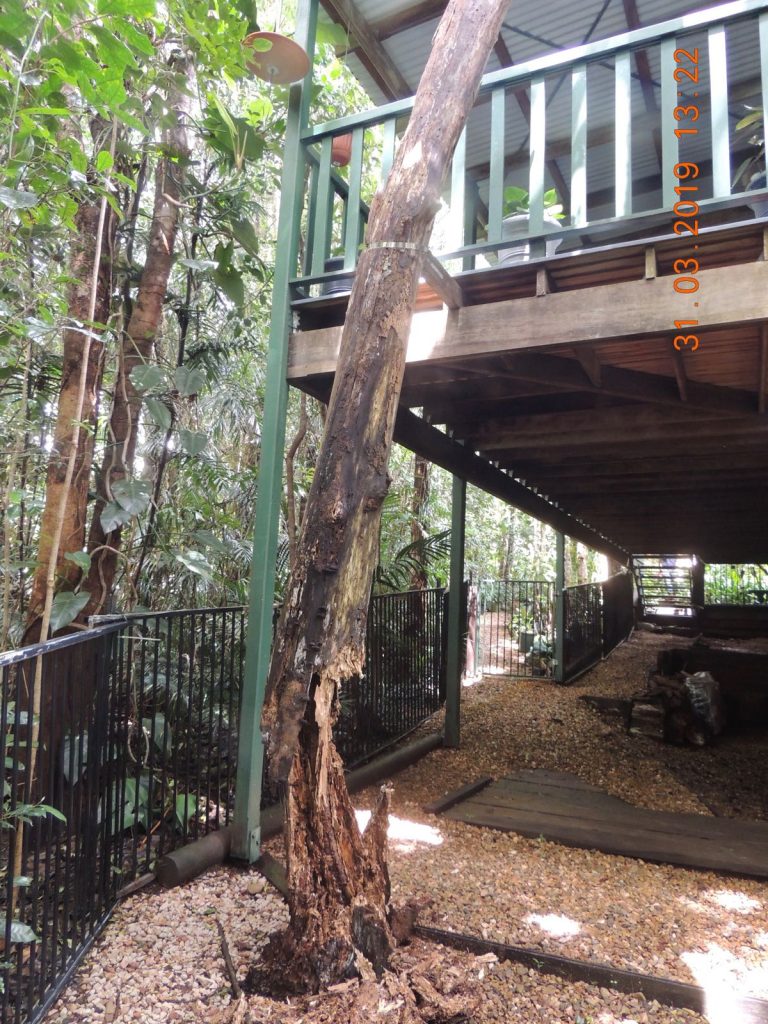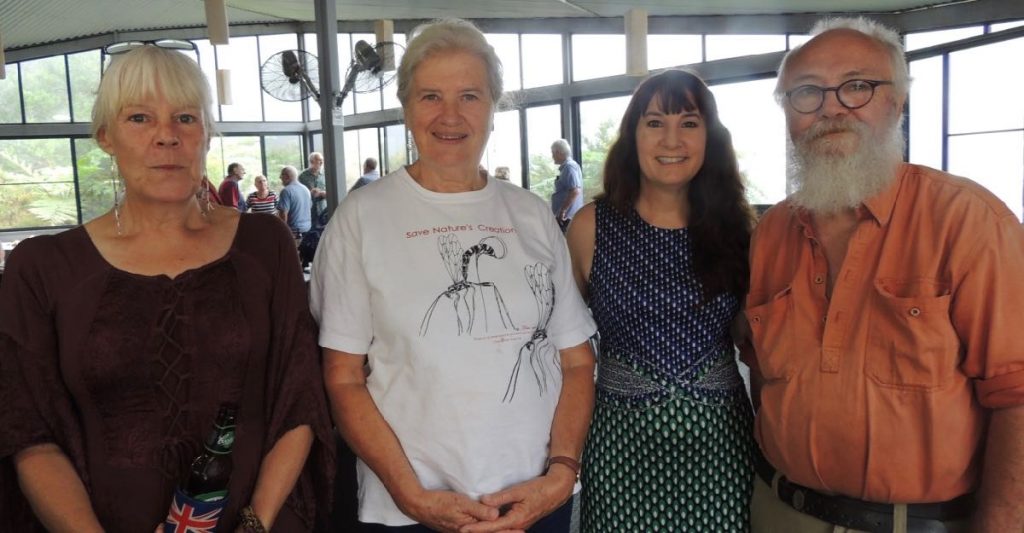

Good morning,
Hope you are starting to dry out a little up there. We have a school holiday activity on the 11th of April, if you would like to share if there are any younger members of your community.
We enjoy checking out your webpage and try to keep up to date with any events you have, so as we can share to Rollingstone and surrounds.
Attached is some information about a Circus Acrobat group that will be held at Rollingstone Community Centre next week. Please feel free to share.
Kindest regards,
Mark Eberle
Community Centre Assistant
Rollingstone Community Centre
Ph: 07 47707855
E: rollingstonertcreception@gmail.com


Well, it was a sad day on Sunday 31 March 2019 at No. 13 Mt Spec Road, Paluma. I have to report that the world famous stump and the dancing perch for many a Victoria’s Riflebird over nearly two decades – is no more. The tree trunk finally succumbed on Sunday morning to the natural elements, wood rot and ongoing decay, to collapse beyond repair.
The story goes………….
When Andy and Ann Bishop built the cedar cottage at No. 13 Mt Spec Road nearly 20 years ago they wanted to maintain as many of the native rainforest trees as possible on their ‘bush block’. They felled only enough trees to allow them to build their dream house amongst the rainforest.
Don Battersby reports that it was about 2004, well after the house was completed that one of the sizeable trees close to the house presented some problems. As the tree continued to grow, the foliage was intruding onto the roof and the verandah. Andy decided to lop the tree, leaving only the tree trunk standing – some 5 metres tall with a flat-top within arm’s length of the verandah.
It was not too long before the local Riflebirds noticed this purpose-built, elevated dancing platform in the canopy. Thus, it soon became a hive of activity for performances and courtship rituals during the breeding season (July-December). Every year since, countless birds have displayed on this stump and it continued to be visited and utilised – right up until it collapsed last Sunday.


The stump at No. 13 has been a draw-card for locals, visitors, bird enthusiasts and photographers from around Australia and the world. Brian O’Leary’s superb photographs and video of the Paluma Riflebird’s courtship rituals were captured on this very stump. (These images are included on the Birds of Paluma DVD). Indeed, some years ago Sir David Attenborough called in at No. 13 to view the Riflebirds.
Many a leisurely Sunday morning at No. 13 has been (pleasantly) interrupted in the early hours by enthusiastic bird photographers dropping in to see if the Riflebirds are displaying on the stump!
Quite remarkably, I made the decision to buy the house at No. 13 largely based on this stump! It was a rather chilly Sunday morning in May 2016 when I first visited Ann and Andy to look at the house. I walked onto the verandah and soon after my arrival the Riflebirds landed on that stump and started displaying. I decided there and then that this was the house for me! At that stage, I had not even been inside to look at the interior of the house. Quite an expensive stump really….!!
It was about 18 months ago that it became clear that the tree trunk was virtually hollow and that it was succumbing to wood rot and decay. With the expert assistance of Don Battersby and Brian O’Leary (who were lamenting its inevitable loss as much as I was) we undertook some repair and remediation works. Don put a strong steel brace around the tree trunk, attaching it to the verandah to provide some much-needed support and stability. This worked well for a year or so. Riflebirds continued to use the platform, even though the dance floor was getting smaller and the trunk had started to wobble quite considerably when the dance moves became too frantic or enthusiastic.

In more recent times and especially since the relentless rainfall this wet season, my frequent inspections had revealed that further repairs would be fruitless. It was going, going, going and on Sunday the tree trunk collapsed at the base. It was gone.

But this story doesn’t end here…….
The search is now on for a replacement tree trunk. With the help of a certain local timber-cutter we hope to find a 5 metre tall straight and solid tree trunk that we can erect and secure in the same place. Our mission is to have the new ‘dance floor’ prepared, installed and reinstated before the commencement of the Riflebird breeding season in June-July.
Once it’s in place, we plan to host Paluma’s first ever ‘stump-warming ceremony’ – to officially welcome the Riflebirds to their new performance platform in the canopy at No. 13 Mt Spec Road.
Text & Photos by Michele Bird

The Eastern Water Skink (Eulamprus quoyii) is a relatively large skink, growing up to 30cm in length. These skinks are common at Paluma and are often observed in gardens and on walking tracks, mostly basking in the sun. I have skinks living in and around my garden, in the garage and on the roof of the house. Mostly I see them when I am gardening and especially when I am disturbing the mulch or leaf litter. They wait nearby, closely watching the ground for any movement of insects for them to eat. Their diet consists of small invertebrates including worms, snails, insects and spiders and smaller lizards. They have also been recorded eating ripe fruits and berries.
As their name suggests, Eastern Water Skinks love the water. They are adept swimmers and can remain submerged for some time. They tend to live close to streams, creeks and waterways, as well bushland and vegetated urban areas.
As reptiles, Eastern Water Skinks need to generate body heat by basking in the sun – they are solar-powered skinks! They also regulate their temperature by cooling off in water. I have often seen them seeking out the sprinkler on hot summer days to sit under the cooling sprays of water.
These skinks have beautiful colouration which also makes them masters of camouflage in the garden and amongst the rocks and foliage of bushland. Their upper body is dark to golden brown in colour with a coppery-olive sheen. Along their sides they are dark-brown to black in colour with whitish spots and a yellow to white stripe that runs along each side of the body from the eyes to the tail. The underside (belly) is usually pale white or grey in colour.

During the month of April, these skinks will start preparing for winter by basking in the sun for many hours and by feeding as much as possible. In winter they will brumate – this means they conserve their energy by resting much of the time and they will only leave their shelter to search for food when necessary. They do not fully hibernate, but they reduce their activity substantially compared with the warmer months of the year.
Eastern Water Skinks mate during spring and the female gives birth to live young, usually between two and nine young in each litter. The tiny baby skinks are independent from birth.
To encourage these beautiful skinks into your garden, plant some low-growing native shrubs and ground covers. Place mulch, leaf litter, rocks, logs, sticks, branches and other places for them to shelter around the garden. A water feature such as a small pond or birdbath will also encourage their visitation – with the added benefit of bringing in the birds and frogs too!

Text & Photos by Michele Bird (For Roy who inspired my interest in these skinks and who was originally going to write this article).

One of Paluma’s very own artists, Sarah Swan will join two of her esteemed artistic colleagues, Heather Byrne and Linda Bates, to present the upcoming ‘Ecologica’ Exhibition at the TYTO Regional Art Gallery in Ingham.
The ‘Ecologica’ Exhibition will run from 5 April to 5 May with opening hours of 10 am to 4 pm daily. Entry to the Exhibition is free of charge and all are welcome.
Sarah invites her Paluma friends and family to join her at the Exhibition Opening on Friday 5 April at 6.30 pm.
Information on the Exhibition is outlined below:-
‘Ecologica’ is the result of the collaboration between three artists who are passionate about the flora and fauna of our beautiful planet. We live surrounded by outstanding landscapes. From the brilliant ochres of the desert, to the lush greens of the tropical rainforest there are more colours around us than our eyes are capable of seeing. ‘Ecologica’ has given us, as artists, the chance to explore these landscapes through our chosen media. Our work is inspired by the life nurtured in our chosen landscapes from the clean tang of saltwater, through the expectant hush of a woodland clearing.

NATIVE BEES AT PALUMA
I am not a beekeeper as such, but I do like to think I am ‘keeping’ plants for the bees. Now that I am a keen gardener (Paluma does that to you!) I read lots of books and magazines on how to improve my gardening skills. ‘Keep the good bugs’ has been the consensus of many authors. In his book, The Bee Friendly Garden, Doug Purdie says “Bees are our most important pollinators and they are in decline the world over…….conventional gardens that favour lawns and pesticides over flowers and edible plants are scaring the good bugs away”.
With that in mind, I often wander around my garden to see who is visiting. I sometimes take my camera to see if I can catch the action.
The Teddy Bear Bee is one of my favourite native bees. This bee can grow up to 15 mm long and makes its nest at the end of a burrow up to 10 cm long in creek beds or garden rubble. This one was enjoying itself on my Melastoma affine (blue-tongue shrub) and the flowering salvias in my back garden.


Another regular garden visitor is the Great Carpenter Bee. At first I thought this was a bumble bee, but apparently Australia has no native bumble bees. This is the largest Australian bee growing from 15 to 24 mm. They cut nest burrows in soft timber such as the dead limbs of mango trees. I wonder where my visitors are living…..?




I have also seen the Blue-Banded Bee in my garden, about the size of a honey bee, and evidenced the possible presence of one of the 150 described species of Leafcutter Bees.
I am not an expert on bees – just an interested spectator, but if you have any questions I might know the answer, or know where to look.
Happy gardening and remember ‘Plant for the Pollinators.’
Text & Photos by Jennie Robinson
On Saturday 16th March, an Afternoon Tea was held at the Rainforest Inn to honour the memory of the late Roy Mackay, one of Paluma’s most loved, admired and respected residents, who passed away on the 12th February.
A year ago, the community helped Roy celebrate his 90th birthday at the Inn. Roy was born on the 18th March. It had been hoped that he would be here for his 91st birthday, but sadly, he did not make it.
The Inn was crowded, with more than 55 guests, not only residents but also others whom his life had touched – birdwatchers, students, taxidermists, fellow nature lovers – all came to reflect on his life and share memories. Again and again, his enthusiasm for life, his kindness and his generosity were mentioned. Many who were unable to attend the afternoon tea sent messages recalling their association with Roy.
Beth Snewin gave a Power Point presentation she had compiled, showing photos and commentaries on Roy’s remarkable life. A guest book was also passed around in which people shared anecdotes and reminiscences. This book will be kept in the Paluma History display as a tribute to this remarkable man’s contribution to the people of Paluma – our very own national treasure.
Always a very sociable man – we are sure Roy would have enjoyed this tea party immensely.














St Patrick’s Day Celebrations at Paluma
Paluma traditionally celebrates ‘La Feile Padraig’ [The feast of Patrick] on the Saturday nearest to the actual day, 17th March. This year we were one day ahead on Saturday 16th. Due to the afternoon tea in celebration of the late Roy Mackay the starting time was delayed to 19.00hrs, but in the event it was near 19.30 hrs before we were eating. There was a great selection of dishes with an Irish flavour including, potato bake, chicken casserole, devilled eggs and many others. Desserts included a wonderful green creamy delight, Guinness brownies, bread and butter pudding and pavlova.

With over 30 people attending, it is needless to say the bar did a brisk and lively trade but, surprisingly, there was some Guinness left over. There was a lucky shamrock under a chair and it is amazing how difficult it proved in finding just which chair!

Many attendees wore their best green gear and several leprechauns appeared out of the Paluma mist, so that the community hall was a sea of Irish green.


Lynn took on the role of Quiz Master for the evening – she said that Les’ questions were too hard – challenging geographic, musical and Irish general topics. There were several participants who scored 13 out of 17 which is an extremely good show of knowledge. The tie-breaker question saw the winner – Wendy Kaus – collect her bottle of wine. Les threw in a few Irish jokes and the buzz of conversation lasted late into the evening.


The highly efficient washing up crew’s work was greatly appreciated. It was a most enjoyable night.
Assistant Editors Note: Many thanks to Les and Lynn Hyland for their hard work in decorating the hall, stocking the bar and making the event a great success!



Text by Les Hyland and Photos by Michele Bird